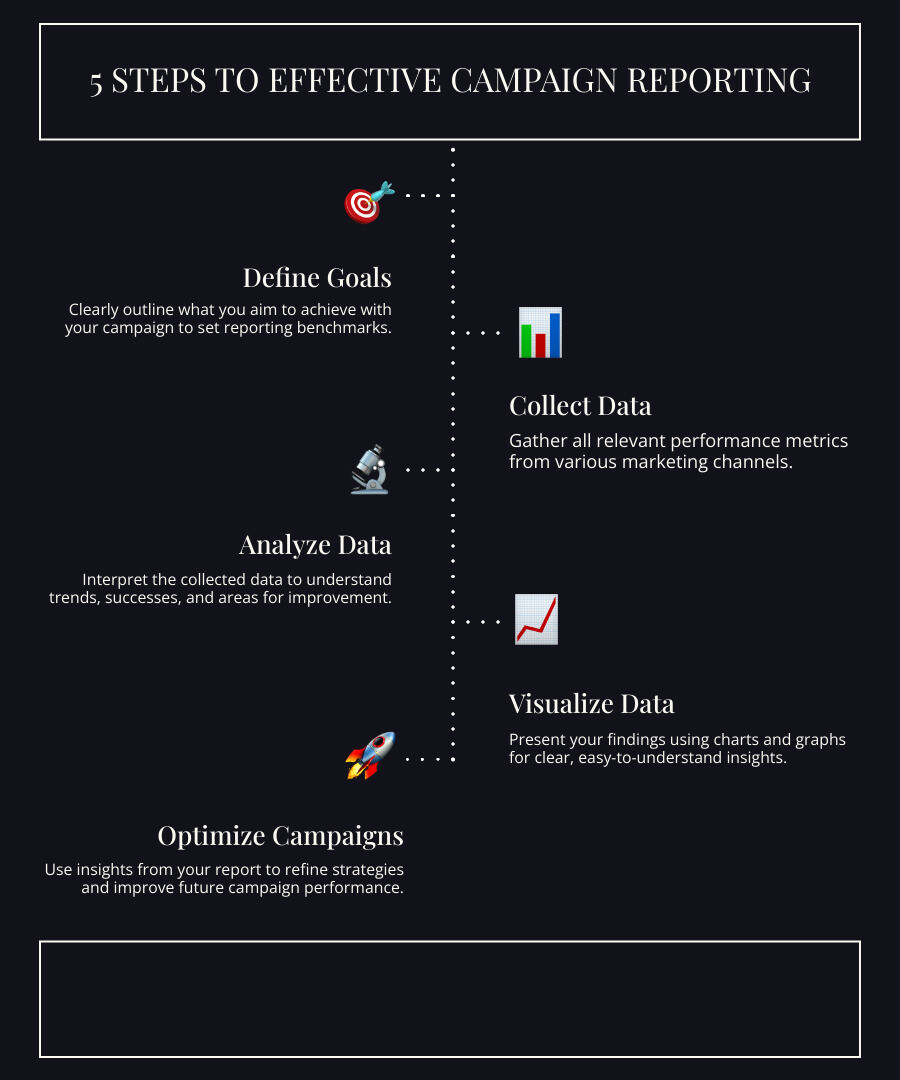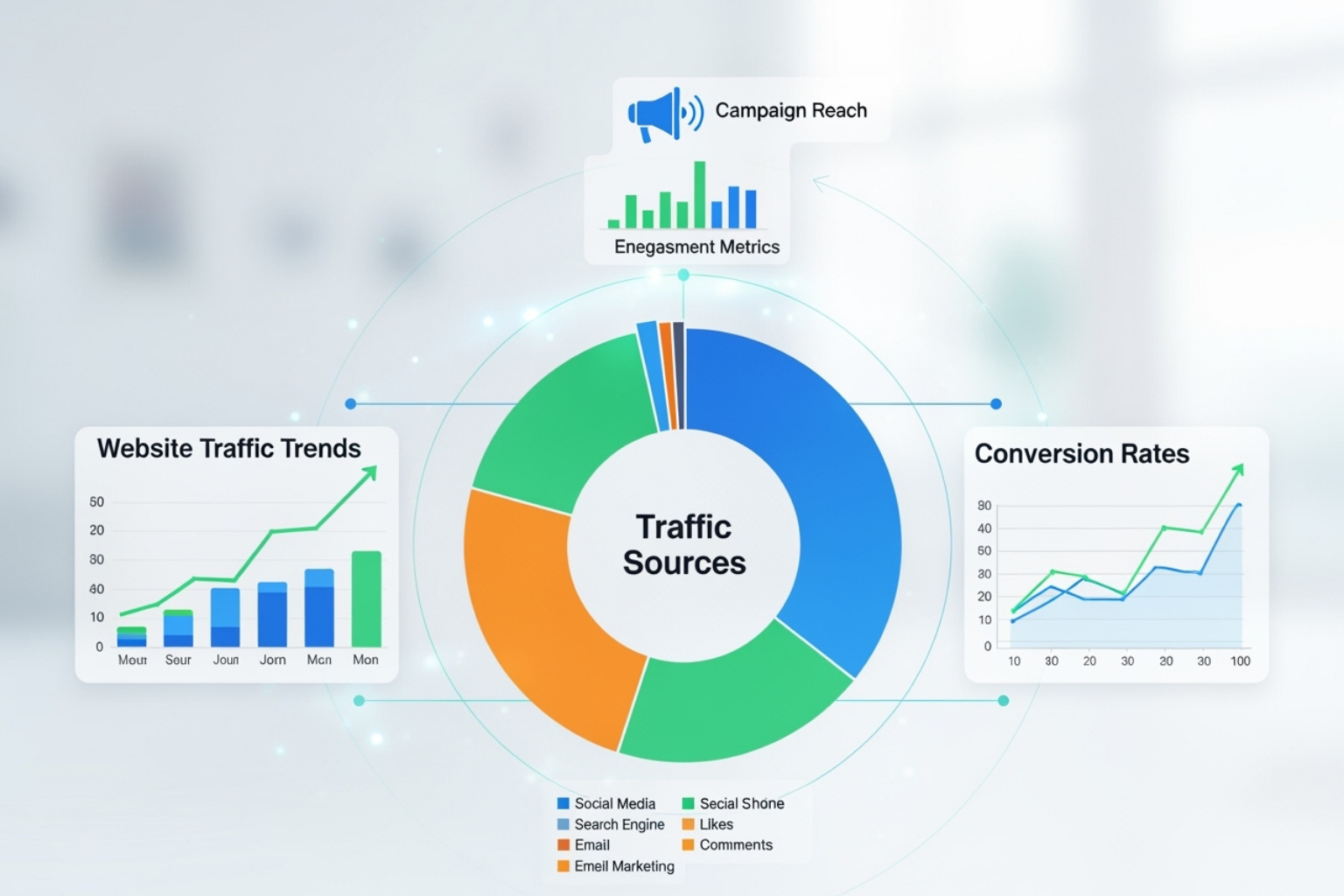Understanding Digital Campaign Performance Reporting
"The campaign was a raving success" might sound exciting. But in digital marketing, true success needs proof. This is where digital campaign performance reporting comes in.
What is digital campaign performance reporting about?It’s about turning your campaign data into clear, actionable insights. This helps you:
- Understand campaign effectiveness.
- Make informed decisions for the future.
- Improve your marketing efforts.
- Prove the value of your work.
It’s about more than just numbers. It helps you turn messy data into a clear story showing what worked well and where you faced challenges. It maps out your marketing experience, making your data easy for everyone to understand and see the full picture of your campaign's performance.
As an e-commerce growth specialist for over two decades, I've seen how important accurate digital campaign performance reporting is for online businesses. My experience with Shopify stores has focused on turning messy data into clear plans that drive real growth and show marketing value.

Simple digital campaign performance reporting word guide:
- campaign management in digital marketing
- how to optimize digital marketing campaigns
- best digital marketing campaigns of all time
What is a Campaign Performance Report and Why Does It Matter?
A campaign performance report is like your marketing campaign's report card. It's a summary showing what your marketing efforts achieved over a set time. More than just numbers, it’s a powerful tool that helps you make smarter choices.
With so much information online, proving your success with solid data is essential. These reports show how your marketing directly helps your business goals. They help you show the real value of your marketing budget and plan your next moves.
The Importance of Data-Driven Decisions
Marketing choices should never be based on guesswork. Without good data, it's like steering a ship blindfolded! Digital campaign performance reporting provides the facts you need to back up your decisions. It helps create a culture where every action is based on real insights, so you can confidently put your money and effort where it truly makes a difference.
Regularly measuring and reporting on your campaigns offers several benefits:
- Drive business growth: Data-driven companies often grow faster because data shows you what works, so you can repeat your successes.
- Improve how you use resources: Knowing which channels and tactics bring the best results helps you put your money and time where they matter most.
- Prove ROI (Return on Investment): This is key to showing the worth of your marketing. It’s how you show that your campaigns are bringing in more money than they cost.
- Support always getting better: Reports aren't just a look back. They are a springboard for what you do next, helping you learn from wins and challenges to make each new campaign better.
Want to learn more about how we help with marketing campaign strategy? You can find more information here: More info about marketing campaign strategy services.
Setting the Stage: Goals and Objectives
Before building a report, you need to know exactly what you want to achieve. What are your campaign goals? Are you trying to increase brand awareness, website traffic, leads, or sales? Each goal needs different metrics to measure success.
I always suggest setting SMART goals: Specific, Measurable, Achievable, Relevant, and Time-bound. For example, instead of "increase sales," aim for "increase online sales by 5% over the next three months." This makes your goal clear and measurable.
It's also important to set up benchmarks from past performance, industry standards, or competitors. Benchmarks give your data meaning. A 10% conversion rate might sound good, but if your industry average is 15%, you know there’s room to improve.
Finally, connecting your marketing and sales teams is very important. Marketing brings in leads, but sales closes the deal. When both teams have shared goals and transparent reports, everyone works toward the same business goals. This teamwork is super important for growth, as nearly 87% of sales and marketing leaders believe.
Building Your Report: Key Components and Metrics
A good report is well-organized and focuses on the metrics that truly matter. Instead of including every data point, focus on those directly connected to your campaign goals. This makes your report easy to follow and tells a clear story.

Essential Sections of a Campaign Report
Think of your report as a story with a beginning, middle, and end. Here are the sections I find essential:
- Executive Summary: A quick overview of campaign performance, highlights, and key challenges. Make it clear and effective for busy readers.
- Key Findings: Share the most important things you learned. What were the big wins and tricky parts of the campaign's experience?
- Channel-Specific Breakdown: Digital campaigns often run across many places like social media or email. This section breaks down how each channel performed.
- Actionable Recommendations: Suggest the next steps. What should be done to make future campaigns even better?
- Conclusion: A short wrap-up that repeats the main takeaways and highlights the campaign's overall impact.
Defining Success: Your Guide to Digital Campaign Performance Reporting KPIs
Key Performance Indicators (KPIs) are the specific numbers you track to see if you're reaching your goals. It's important to pick a few KPIs that are most relevant to your campaign and business goals.
Here are some basic KPIs I often include in digital campaign performance reporting:
- Conversion Rate (CR): The percentage of people who take the action you want them to take, like buying a product. It’s a direct measure of your campaign's success.
- Customer Acquisition Cost (CAC): How much it costs to get a new customer. This helps you know if you're spending your marketing money wisely.
- Return on Ad Spend (ROAS): For paid campaigns, this measures the revenue earned for every dollar spent on ads. It helps you get the most from your ad budget.
- Click-Through Rate (CTR): The percentage of people who click your ad or link after seeing it. A high CTR means your message is grabbing attention.
- Engagement Rate: Especially for social media, this measures how your audience engages (likes, shares, comments). High engagement can help your content reach more people.
For more detailed insights into how we handle analytics, check out our e-commerce analytics services.
Channel-Specific Metrics to Track
While overall KPIs give the big picture, channel-specific metrics help you understand the details on different platforms.
- Email Marketing: We track Open Rate (if your subject lines work) and Click Rate (if your content and calls to action are effective). For example, high open rates but low clicks suggest the email content needs work.
- Social Media: We check Reach (unique people who saw your content) and interactions like Likes, Shares, and Comments. Many shares can help your content spread further.
- SEO: We track Organic Traffic (visitors from free search results) and Keyword Rankings (where you rank for search terms). Better rankings mean more visibility.
- Paid Ads: We look at Cost Per Click (CPC) (how much you pay per click), Impressions (how many times your ad was shown), and Conversions (the actions you want from your ads).
Presenting Your Data: How to Tell a Clear Story
How you present data is as important as the data itself. The goal is to make difficult information easy to digest for everyone, from your marketing team to company leadership. A clear presentation helps everyone understand the campaign's impact and agree on the next steps.
The Power of Data Visualization
Looking at raw numbers can feel like reading a phone book. Data visualization turns overwhelming numbers into easy-to-understand pictures. A simple line chart can show website traffic changes over time, while a pie chart can show sales splits by category. Visuals like bar charts, line graphs, pie charts, or heatmaps highlight key trends and insights at a glance, making the data much clearer for everyone.

Tailoring Reports for Different Audiences
Not everyone needs the same level of detail. A CEO doesn't need to see every click, while a social media manager needs more than just overall sales. I always adjust my reports for the audience.
- For executives: I focus on the big picture, including key metrics tied to business results like revenue or return on investment (ROI). They want the bottom line.
- For the marketing team: I give more specific information, like channel metrics, A/B test results, and practical insights to help them fine-tune their work.
- For clients: I highlight successes and clearly explain the strategy behind the numbers. It's about showing them how their investment is paying off and discussing what's next.
Telling a Story with Your Data
A great report tells your campaign's story. I build a clear story by answering three key questions:
- What happened? Show the main numbers and trends. Did traffic go up? Did sales increase?
- Why did it happen? Add context and analysis. Maybe a new ad worked well, or a holiday sale boosted conversions.
- What's next? Based on what you've learned, what are the clear next steps? What changes will you make for the next campaign?
This storytelling approach turns raw information into smart, usable ideas. It clarifies how your campaign unfolded and what lessons you can apply moving forward.
Tools and Tech to Make Reporting Easier
Manually creating marketing reports is like counting sand on a beach—time-consuming and prone to error. Luckily, modern tools can do the heavy lifting, pulling data from various sources into one easy-to-read spot. This frees you up to focus on what the numbers mean and plan your next move.

Tools to Simplify Your Digital Campaign Performance Reporting
Automation has made digital campaign performance reporting much smoother. Here are some key tools I rely on:
- Google Analytics: An essential tool for understanding website visitors. It shows you how people find and move through your site, what pages they visit, and what actions they take. It helps you understand visitor numbers and their experience.
- Dashboard Software: Tools like Google Looker Studio, DashThis, or Metrics Watch are great for building custom dashboards. They pull data from sources like Google Ads, Facebook, and Mailchimp into one central view, saving you from switching between platforms.
- Automated Reporting: Many platforms offer automated reporting, which is a huge time-saver. These systems create consistent, accurate reports on their own, letting you spend more time on strategy.
The Future of Reporting: Automation and AI
Digital campaign performance reporting is getting smarter. The future is about automation and smarter tools, with the predictive analytics market growing at about 23.2% annually.
- Predictive analytics uses past data to guess what might happen next. This can help you make smart choices before problems even come up.
- AI-powered insights can find important patterns in your data much faster than a person could, highlighting things you might have missed.
- Automated recommendations from AI can suggest specific changes to your targeting, budget, or creative. These tools let you focus on big-picture thinking instead of repetitive data work.
For example, our Shopify automation services can help you bring these advanced tools into your e-commerce business.
From Report to Results: Driving Strategy and Avoiding Mistakes
The goal of digital campaign performance reporting is to improve your marketing. It’s about using numbers to make smart choices, creating a cycle of always improving that leads to better results.
Using Insights to Improve Future Campaigns
Think of your reports as a starting block for your next win. I use report findings to get better by:
- Identifying successful tactics: If something worked well, we do more of it or expand on the idea.
- Improving areas that aren't doing well: If an ad or channel didn't perform as hoped, the report helps me figure out why so we can make the right changes.
- A/B testing: Reports often show areas ready for testing. For example, trying different headlines on a landing page to see what connects best with visitors.
- Moving the budget: We move spending from channels that aren't performing to those that are, making every dollar work harder.
- Strategic planning: Over time, reports build a clear picture of what works, helping create strong, long-term marketing plans built on real success.
Common Mistakes to Avoid in Your Reporting
It's easy to make mistakes in reporting. Here are a few common traps to avoid:
- Data overload: Including too many numbers can be confusing and hide the most important insights. Focus on the metrics that matter to your goals.
- Vanity metrics: These are numbers that look impressive but don't help your business grow (e.g., lots of ad views but no clicks or sales). Ask if the metric helps you make a better decision.
- Ignoring context: A number by itself doesn't tell the whole story. Always explain why numbers went up or down.
- Lack of actionable insights: A report should lead to action. It should always answer the question: "So, what do we do now?"
- Inconsistent tracking: If you change how you collect data mid-campaign, your reports won't be reliable. Keep your data collection consistent.
- Poor data visualization: Messy or confusing charts can ruin good data. Keep visuals clean and easy to read.
Frequently Asked Questions about Campaign Reporting
I often get asked similar questions about digital campaign performance reporting. Here are some of the most common ones:
How often should I create a campaign report?
The right timing depends on your campaign's length and goals. For ongoing campaigns where you need to make quick changes, a weekly or bi-weekly report is helpful. This lets you adjust things on the fly.
For longer-term plans, a monthly report gives a good overview of trends. For campaigns with large budgets or critical decisions, bi-weekly reports might be best. It's about finding the right balance between getting information and having time to act on it.
What's the difference between a dashboard and a report?
Think of a dashboard as your car's dashboard—it gives you a live, real-time view of key metrics. It's perfect for daily checks and shows what's happening right now.
A report is a more detailed document created at specific times (e.g., weekly or monthly). It gives a deeper look, explaining why things happened and what to do next. A dashboard shows the what; a report explains the why and the what's next.
How do I report on a campaign that didn't meet its goals?
It happens! When a campaign doesn't hit its targets, be honest and treat it as a learning opportunity. Don't hide the numbers. Instead, show what didn't work and, more importantly, explain why you think it happened. Was the targeting off? Was the ad creative weak?
Then, share a clear plan with the specific changes you'll make to do better next time. This shows you've learned from the experience and have a solid plan to improve, which helps build trust.
To Sum Up: Make Your Data Work for You
To sum up, digital campaign performance reporting is more than just looking at numbers; it's your key to real, lasting growth. By digging into your data for clear insights, you can improve your plans, show the value of your work, and get better results every time.
It’s about turning data into a simple story that helps your whole team win. This story shows what worked and what needs a tweak, guiding you toward bigger successes.
Here at First Pier, we love helping e-commerce businesses like yours. We turn data into smart choices that help you grow. If you're ready for a marketing strategy that's built on strong, clear reporting, we're here to help. Explore our e-commerce analytics and analysis services and let's get started!







